Use Group Policy Filtering to create a DHCP enforcement policy for NAP - Part 2
Thomas Shinder
Network Administration - In the first part of this series, we introduced some basic knowledge about how NAP works, then installed DHCP and NPS services on the NAP policy server. In this section, I will show you how to use the NAP policy wizard to automatically create Network, Health, and Connection policies to control access to your network.
Use the NAP Wizard to create an NAP DHCP enforcement policy
Now we can start the main part - create a NAP DHCP enforcement policy. After running the wizard, the wizard will create the following policies:
- Health Policies
- Connection Request Policies
- Network Policies
- Remediation Server Group policies
Let's take a closer look at each of these policies after finishing the wizard.
Open the Network Policy Server console from the Administrative Tools menu. From here, you will see the middle of the interface appear the page Getting Started. In the Standard Configuration section, select the Network Access Protection (NAP) option from the Select configuration scenario from the list and then click the link below to open the wizard scenario .
Click the Configure NAP link.
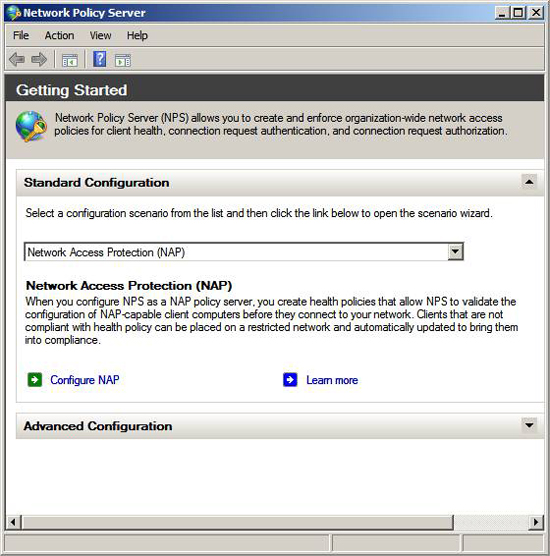
Figure 1
On the Select Network Connection Method For Use page with NAP , the Network connection method section , select the option Dynamic Host Configuration Protocol (DHCP) from the list. Remember, when using NAP, we have to choose an execution method and that's what we're doing here. The DHCP server becomes 'network access server' in this scenario and the DHCP server is responsible for the network access level that the NAP client has.
The Policy name text box will automatically be populated with NAP DHCP, the name (name) section will be appended to some of the policies created by the wizard. We will see this after finishing the NAP wizard.
Click Next .
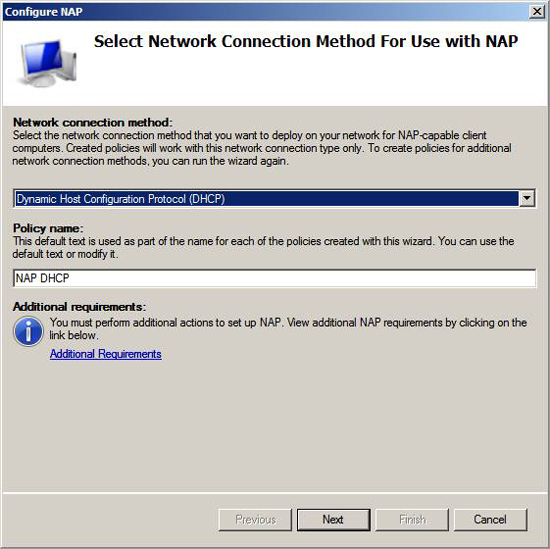
Figure 2
On the Specify NAP Enforcement Server Running DHCP Server page , you can include the IP address of the DHCP server that will be responsible for the network access server. Use this option when the DHCP server and NPS server configure NAP policies that are not on the same server.
If you want to add remote DHCP NAP enforcement servers, they must be configured as RADIUS clients, which means that you need to configure these as NPS servers. The difference here is that this NPS server does not configure NAP policy settings. They only authorize RADIUS requests to the NPS server that is configuring NAP policy settings. This configuration should be used in a large production environment, where the DHCP server and NAP server are both relatively busy. In addition, it is likely that there will be multiple DHCP servers in your company, while you want all to be able to communicate with the NAP policy server or servers.
In this example, the network on which we place DHCP and NPS servers is on the same computer, so we won't need to add remote DHCP servers to the list. Click Next .
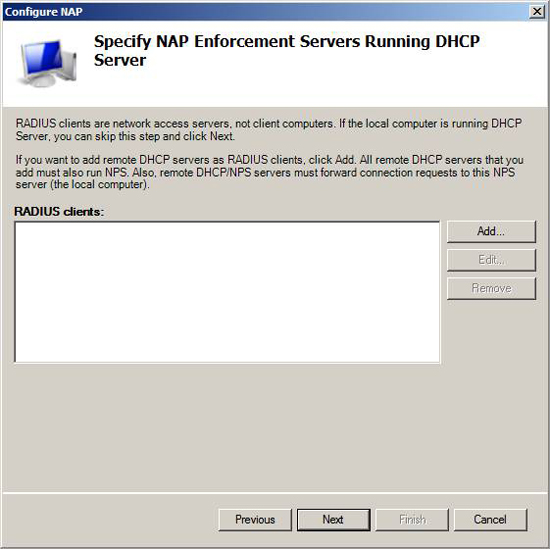
Figure 3
You have an option to enable NAP when using DHCP enforcement. If you do not want to use the NAP enforcement policy for all DHCP scopes, you can enter the scope in which you want the NAP policy to apply to the Specify DHCP Scopes page. In our example network, we want to enable NAP policy on all scopes, so we don't enter specific scopes on this page. Click Next .
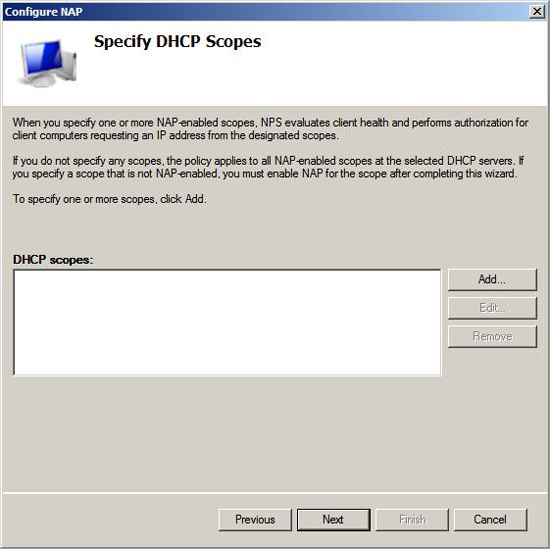
Figure 4
You can allow or deny access to certain user groups or computers in NAP policy. In this example, we apply policies to all machines and users. Click Next.
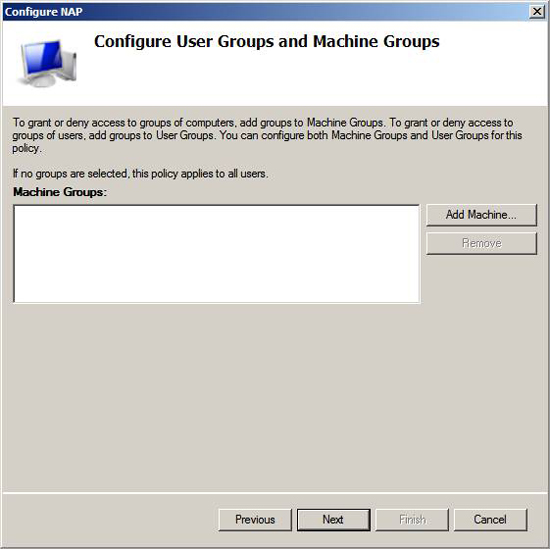
Figure 5
All computers need access to certain servers on the network. They need infrastructure servers such as Active Directory, DNS, DHCP and WINS servers. All computers need access to error-correction servers, which are computers that the computer does not meet the requirements for access to reach consensus.
On the Specify a NAP Remediation Server Group page and URL page , click the Group button to open the New Remediation Server Group dialog box. In the New Remediation Server Group dialog box , enter the group name in the Group Name text box. In this example, we name the group Network Services .
Click the Add button in the New Remediation Server Group dialog box. You will then see the Add New Server dialog box appear. In the Add New Server dialog box, enter the server name in the Friendly name box. In this example we enter a name for the domain controller, so we'll enter DC into this text box. The IP address of the domain controller is 10.0.0.2, so we will enter that address into the IP address or DNS name text box. If you know the name of the DNS server, you can enter that name in the text box and then click the Resolve button.
Click OK in the Add New Server dialog box .
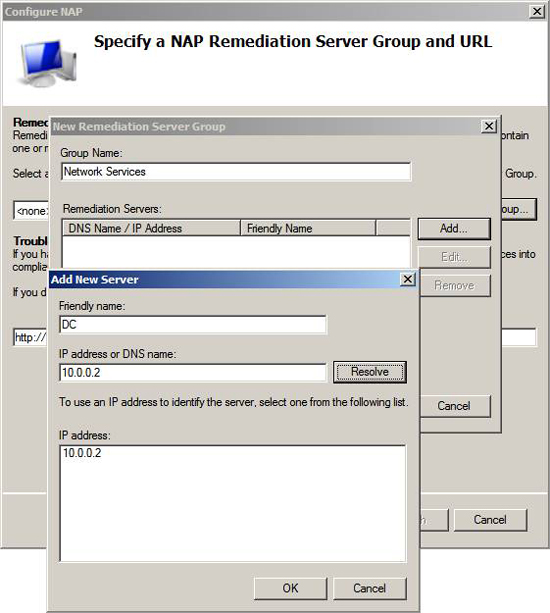
Figure 6
You should now see the name of the server group that fixes the error and the IP address of the server you added to the group. Remember, the purpose of this group is to remove it from the restrictions of NAP policy. The domain controller in this example is a computer that all domain members need to communicate with to log in. If you do not allow your NAP clients, whether they agree or not, to connect to the domain controller, they will not be able to log on to the network to become consensus after logging in.
Click OK in the New Remediation Server Group dialog box .
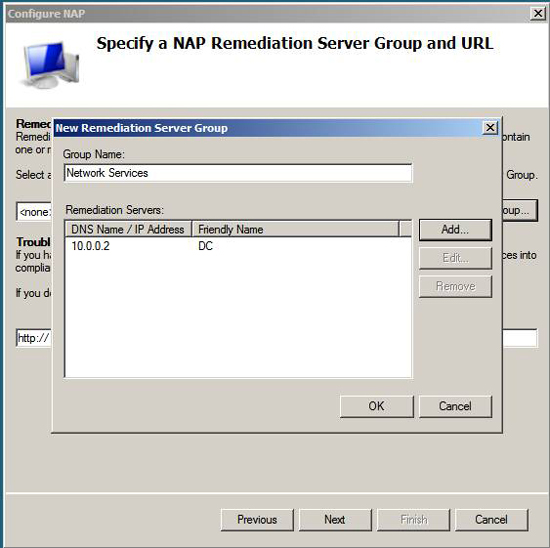
Figure 7
Click Next on the Specify a NAP Remediation Server Group page and URL . Note that we can also enter Troubleshooting URL on this page. We do not use any of this example, but sometimes you use it if you want to point users to a page that shows them how to become consensus after their computer is in a non-compliant state and cannot edit itself. error.
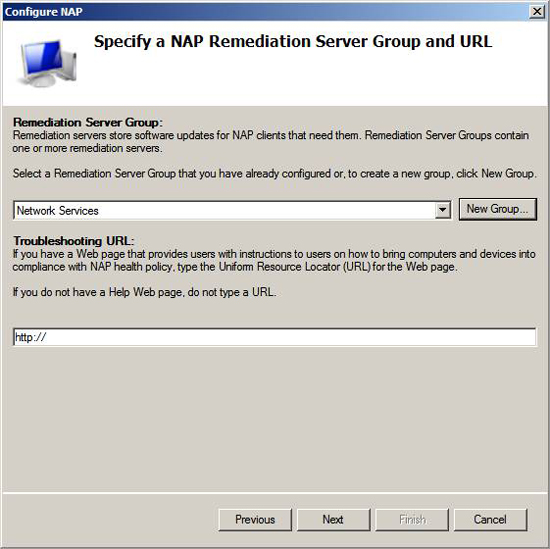
Figure 8
On the Define NAP Health Policy page , you can choose which System Health Validator you want to define a health policy for (Health Policy). By default, there is only one System Health Validator policy available in Windows Server 2008, which is the Windows Security Health Validator . Other software vendors may also group their System Health Validator products that you install into the NAP policy server.
Make sure there is a check mark in the Windows Security Health Validator checkbox. There is also a checkmark in the Enable auto-remediation of client computers check box. This option allows NAP client components to fix some problems on their own. For this example, if Windows Firewall is disabled, the NAP agent will activate Windows Firewall automatically.
In the Access Network restrictions for the NAP-ineligible client computers , you define what you want to do with non -NAP-capable computers . You have two options:
- Full network access to the NAP-ineligible client computers. Cho phép truy cập đến một mạng chế độ bị tắt
- Reject all network access for unqualified NAP clients. Only allow restricted access to the network.
- Allow full network access to NAP-ineligible client computers
- Allow access to unqualified NAP clients
The first option is safer than the other option, while the second option is a more generous option. Your choice depends on the design goal for NAP. You can allow non-NAP-capable computers to access the network during the NAP deployment process and then, when the deployment process is complete, you will switch and execute the NAP consensus machines.
Click Next on the Define NAP Health Policy page .
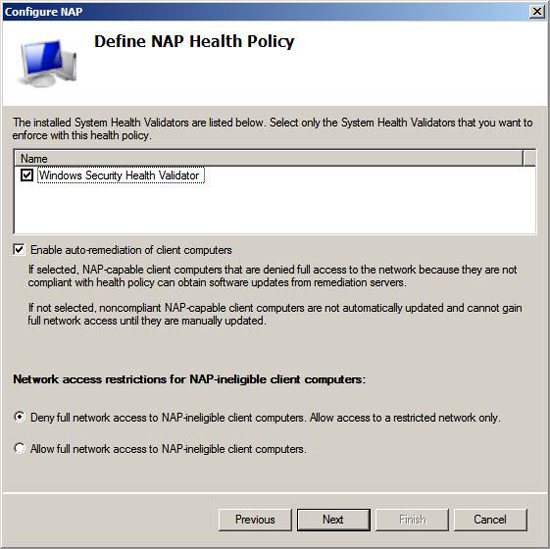
Figure 9
On Completing NAP Enforcement Policy and RADIUS Client Configuration pages, you can see Health Policies , Connection Request Policies , Network Policies and Remediation Server Group will be created by the wizard. We will take a closer look at these policies.
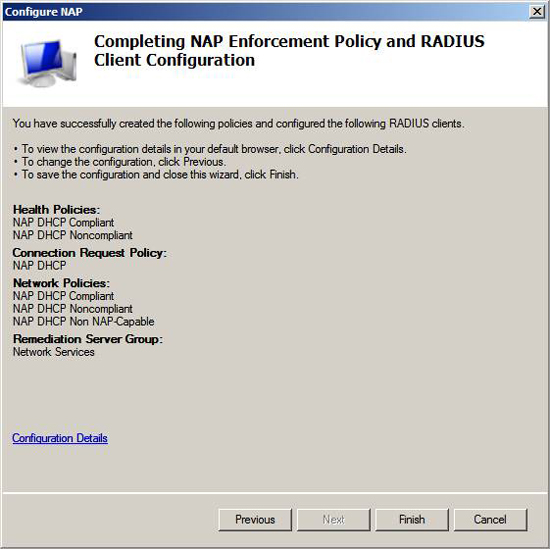
Figure 10
Note that there is only one Configuration Details link. When you click on this link, it will appear a page that provides detailed information about each policy that will be created by the wizard.
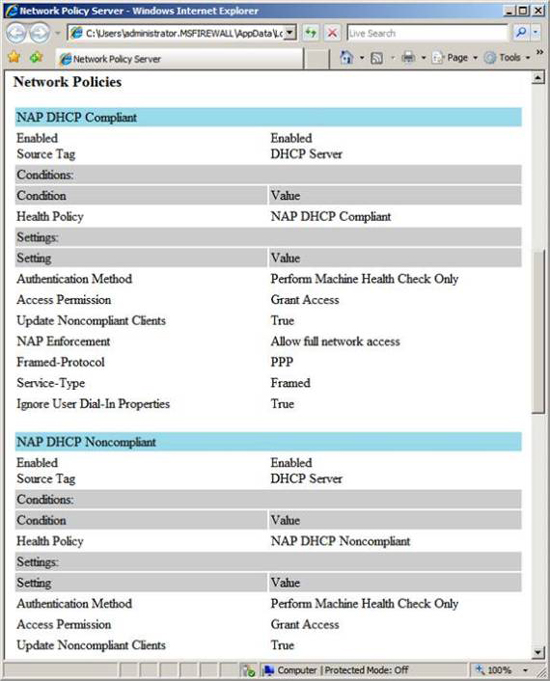
Figure 11
Conclude
In this part 2, I have discussed the NAP policy wizard and explained each option provided by this wizard. We have seen that the NAP policy wizard makes it much simpler to create a comprehensive NAP policy in the process of creating some Network, Health and Connection policies to control which computers can join the network. In the next part of this series, we will take a closer look at the rules and explanations of functions as well as the basic elements behind each of these rules.
You should read it
- How to reset Local Group Policy settings on Windows 10
- 8 'tweak' Windows Group Policy any Admin should know
- 10 important Windows Group Policy settings need to be done immediately
- 4 tips to open Local Group Policy Editor on Windows 8 / 8.1
- Install the printer using Group Policy Object
- Secure Endpoint with Group Policy
- How to apply Group Policy only to non-administrators in Windows 10
- Configure App-V with Group Policy Objects
May be interested
- How to apply Group Policy only to non-administrators in Windows 10
 if you want to apply a policy to a specific user, read the following article to learn how to do it.
if you want to apply a policy to a specific user, read the following article to learn how to do it. - Configure App-V with Group Policy Objects
 group policy objects are increasingly used in centralized management of settings, especially for software products installed on many systems.
group policy objects are increasingly used in centralized management of settings, especially for software products installed on many systems. - 10 important Windows Group Policy settings need to be done immediately
 configure the 10 group policy below carefully and enjoy better windows security for your computer.
configure the 10 group policy below carefully and enjoy better windows security for your computer. - 11 tips to open Local Group Policy Editor on Windows
 on local group policy editor, you can set up deletion of notification history, set up account lock to limit the number of login times, etc. in the article below, tipsmake.com.com will introduce to you a several ways to open local group policy editor on windows.
on local group policy editor, you can set up deletion of notification history, set up account lock to limit the number of login times, etc. in the article below, tipsmake.com.com will introduce to you a several ways to open local group policy editor on windows. - Deploying IPsec Server and Domain Isolation with Windows Server 2008 Group Policy - Part 2
 in this part 2, we'll move on to the second step, which is the step to install and configure the network policy server, the health registration authority and the subordinate ca.
in this part 2, we'll move on to the second step, which is the step to install and configure the network policy server, the health registration authority and the subordinate ca. - System Administration with Group Policy in Windows XP - Part I
 in windows xp there is a nice tool, group policy (gp). many windows users have been around for a long time but have never known this tool because they cannot be found in control panel, administrative tools or system tools. gp is one of the components of microsoft management console and you must be a member of the group
in windows xp there is a nice tool, group policy (gp). many windows users have been around for a long time but have never known this tool because they cannot be found in control panel, administrative tools or system tools. gp is one of the components of microsoft management console and you must be a member of the group - Cannot open Local Group Policy Editor, quick fix
 to change configuration and important windows policies, windows 11 users will use local group policy editor. in case you cannot open the local group policy editor, immediately refer to the information in tipsmake's article!
to change configuration and important windows policies, windows 11 users will use local group policy editor. in case you cannot open the local group policy editor, immediately refer to the information in tipsmake's article! - How to install the Microsoft Edge Group Policy template on Windows 10
 on windows 10, you can download and install group policy templates to manage microsoft edge settings, and this guide will show you the process.
on windows 10, you can download and install group policy templates to manage microsoft edge settings, and this guide will show you the process. - How to disable DHCP in Windows 10
 if you are running a regular home network, devices get their ip addresses through the dynamic host configuration protocol (dhcp).
if you are running a regular home network, devices get their ip addresses through the dynamic host configuration protocol (dhcp). - Secure Endpoint with Group Policy
 group policy is an important mechanism in the network security process. here are some very useful settings to block network access.
group policy is an important mechanism in the network security process. here are some very useful settings to block network access.










 Windows Firewall in Windows Vista
Windows Firewall in Windows Vista Build your own free security suite
Build your own free security suite Use Group Policy Filtering to create a DHCP enforcement policy for NAP - Part 3
Use Group Policy Filtering to create a DHCP enforcement policy for NAP - Part 3 Live Mesh and security related
Live Mesh and security related Great way to be safe when using Wi-Fi
Great way to be safe when using Wi-Fi Deploying IPsec Server and Domain Isolation with Windows Server 2008 Group Policy - Part 1
Deploying IPsec Server and Domain Isolation with Windows Server 2008 Group Policy - Part 1